Keywords
|
| IEEE 802.11P,RTT, TCP,VANET. |
I.INTRODUCTION
|
| VANET is a special type of ad hoc network consists of moving cars referred to as nodes, provide a way to exchange any information between cars without depending on fixed infrastructure. VANET is an autonomous and self organizing wireless communication networks. In this network the cars are called nodes which involve themselves as servers and/or clients for exchanging and sharing information [1].VANET has a combination of Vehicle-to-Vehicle (V2V) and Vehicle-to-Infrastructure (V2I) wireless communication. For instance, when a traffic incident occurs, all the vehicles on the road benefit from timely and accurate information dissemination allowing the drivers to make informed decisions. Thus, reliability and low delay are extremely important factors in VANET safety applications [2]. |
| In particular, the new Dedicated Short Range communication (DSRC) offers the potential to effectively support vehicle-to-vehicle and vehicle-to-roadside safety communications, which has become known as Vehicle Safety Communication (VSC) technologies. As a result of emerging standards, such as 5.9 GHz dedicated short-range communication is used for VANET.A challenging issue in VANETs is congestion control: The Internet is based on an end-to-end paradigm, where the transport protocol (e.g. TCP) instances at the endpoints detect overload conditions at intermediate nodes[3]. In case of congestion, the source reduces its data rate. However, in VANETs the topology changes within seconds and a congested node used for forwarding a few seconds ago might not be used at all at the point in time when the source reacts to the congestion [4].By traffic reduction in the network, the congestion issue is rectified [5]. |
II.COMPARISION BETWEEN MANET AND VANET
|
| Both VANET and MANET are characterized by the movement and self-organization of the nodes. But they are also different in some ways. MANET can contain many nodes that have un-controlled moving patterns. Because of the restricted node movement it is quite likely that the VANET will be supported by some fixed infrastructure that provide some services and access to stationary networks. The comparison between MANET and VANET is shown in table 2.1 |
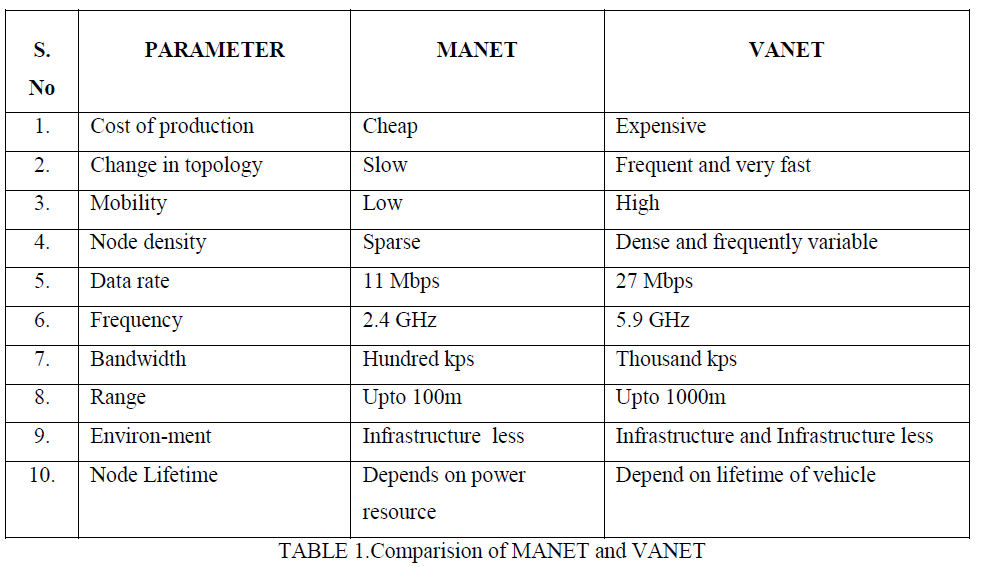 |
III. CHARACTERISTICS OF IEEE 802.11p
|
| IEEE 802.11p, also known as Wireless Access in Vehicular Environment (WAVE), is a draft amendment to the IEEE 802.11 standard that adds applications to fast changing vehicular networks. IEEE 802.11p is an approved amendment to the IEEE 802.11standard to add wireless access in vehicular environments (WAVE).It defines enhancements to 802.11 required to support Intelligent Transportation Systems (ITS) applications [6]. This includes data exchange between high-speed vehicles and between the vehicles and the roadside infrastructure in the licensed ITS band of 5.9 GHz (5.85-5.925 GHz). IEEE 1609 is a higher layer standard based on the IEEE 802.11p. IEEE802.11p will be used as the groundwork for Dedicated Short Range Communications (DSRC), Air-interface, Long and Medium range (CALM) architecture standard looking at vehicle-based communication networks, particularly for applications such as toll collection, vehicle safety services, and commerce transactions via cars. |
IV. TCP CONGESTION CONTROL MECHANISM
|
| One of TCP’s primary functions is the transmission rate of the sender is equal to that of the receiver and the network. It is important for the transmission to be at a high enough rates to ensure good performance. TCP’s 16-bit window field is used by the receiver to tell the sender how many bytes of data the receiver is willing to accept. Since the window field is limited to a maximum of 16 bits, this provides for a maximum window size of 65,535 bytes. |
| TCP continuously observes when data is sent and at what time acknowledgement is received for each packet. TCP uses this information to calculate an estimate of round trip time. As packets are sent and acknowledged, TCP adjusts its round-trip time .If acknowledgements return quickly, the round-trip time is short and the retransmission timer is thus set to a lower value. This allows TCP to quickly retransmit data when network response time is good (The converse is also true). TCP does not retransmit data too quickly during times when network response time is long. |
V. CHARACTERISTICS OF DIFFERENT TCP VARIANTS IN WIRELESS ENVIRONMENT
|
| TCP VARIANTS: There are several TCP variants are used in wireless environments as described below: SACK, New Reno, Vegas, TCP – Hybla, Compound TCP, Zeta –TCP, TCP–Jersey, BIC – TCP, Scalable TCP, TCP – Illinois, TCP – High Speed. Whenever a TCP segment has been sent and the sender’s retransmission timer expires, the sender is forced to retransmit the segment, which the sender assumes has been lost. The sender should only retransmit the lost segment(s) while the receiver continues to queue the later segments. It was only until recently that a mechanism to retransmit just the lost segments in these situations was put into standard TCP implementations. Selective Acknowledgement (or SACK) is this technique implemented as a TCP option that can help reduce unnecessary retransmissions on the part of the sender using the format show in figure 5.1 below. |
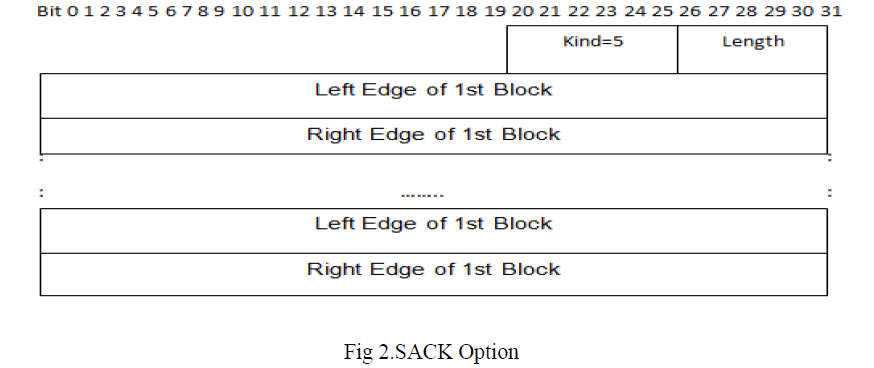 |
| The sender cannot rely upon the receiver to maintain the out-of-order data. Obviously the performance gain is to be had when the receiver does queue and re-order data that has been reported with the SACK option so that the sender limits its retransmissions.TCP–Jersey: It is capable of distinguishing the wireless packet losses from the congestion packet losses and react accordingly. It consists of two algorithm such as, |
| 1. Available bandwidth estimation (ABE) |
| 2. Congestion warning (CW) router configuration. |
| It is a TCP sender side addition that continuously estimates the available bandwidth to the connection and guides the sender to adjust its transmission rate when the network becomes congested. Congestion warning algorithm is a configuration of network routers such that routers alert end stations by marking all the packets when there is a sign of incipient congestion. The marking of packet by the CW configured routers helps the sender of the TCP connection to effectively differentiate packet losses caused by network congestion from those caused by wireless link errors. |
| Binary increase congestion control (BIC) is an implementation of TCP with an optimized congestion control algorithm for high speed network with high latency. So it is called as “Long – fat network”. It has unique congestion window (CWND) algorithm. The main function of this algorithm is try to find the maximum where to keep the window at for a long period of time, by using a binary search algorithm. It is a simple changes to the traditional TCP congestion control algorithm (RFC 2581) which dramatically improves TCP performance in high-speed wide area network. It is used to provide much higher throughput and scalability. It is especially targeted at high – speed and long distance network. The TCP – Illinois is a sender side modification to the standard TCP congestion control algorithm, it achieves a higher average throughput than the standard TCP. It allocates the network resource fairly as the standard TCP, is compatible with the standard TCP. The TCP – high speed (HSTCP) makes minor modifications to the standard TCP’s congestion control mechanism to overcome this limitation. |
| Many of these applications require the use of a reliable end-to-end transport protocol, the most popular of which is TCP. Unfortunately, studies have shown that TCP performance in MANET/VANET is very poor. Inherently, TCP treats packet loss as a sign of network congestion. In wireless networks, however, losses can occur for reasons besides congestion, such as poor channel conditions or collisions. As a result of a loss, TCP will unnecessarily reduce congestion window size, effectively decreasing throughput. In addition, because of the ad hoc nature of VANET network, path symmetry is not guaranteed. This can also decrease TCP performance due to incorrect estimation of RTT times, resulting in unnecessary retransmissions. In the existing system, TCP variants cannot yield good performance in highly mobile environment due to the fact that TCP is not able to differentiate packet drop occur from link failure with that of congestion in network. In the proposal, to overcome the problem of frequent retransmission, a significant RTT timer modification to be made at the TCP sender side. The ultimate intend of the project is to design a new RTT, SRTT and RTO timers for high mobility environment (VANET) in order to improve its performance. |
VI. SIMULATION RESULTS
|
| The simulation result of number of nodes vs end-to-end delay is shown in fig 6.1. It shows that an exclusive examination with the incorrect estimation of existing RTT, SRTT and RTO timers under different TCP variants such as Reno, New Reno, Vegas, Linux, SACK, FACK for vehicular network. . In VANET, the end-to-end delay decreases with number of nodes increases. The analysis was done with Bonn Motion mobility model (Manhattan Grid) that is built over NS-2 simulator. This can decrease TCP performance due to incorrect estimation of RTT times, resulting in unnecessary retransmission which produce excess of congestion in the network. |
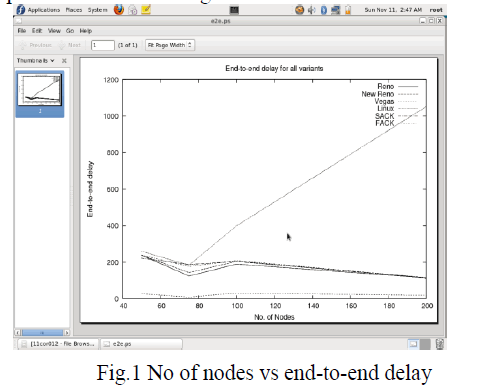 |
| The simulation result of number of nodes vs throughput is shown in fig 6.2. It shows that an exclusive examination with the incorrect estimation of existing RTT, SRTT and RTO timers under different TCP variants such as Reno, New Reno, Vegas, Linux, SACK, FACK for vehicular network. In VANET, the throughput is linearly increases with number of nodes increases.The analysis was done with Bonn Motion mobility model (ManhattanGrid) that is built over NS-2 simulator. This can decrease TCP performance due to incorrect estimation of RTT times, resulting in unnecessary retransmission which produce excess of congestion in the network. |
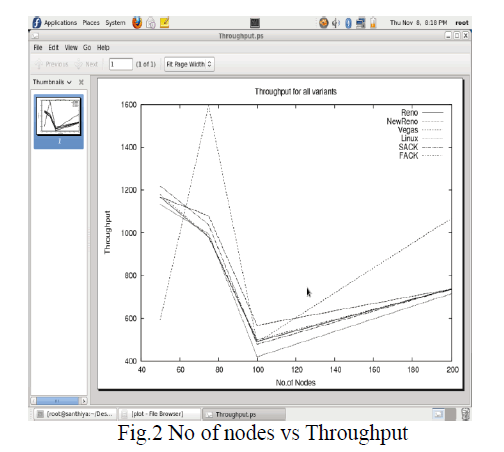 |
| The simulation result of number of nodes vs goodput is shown in fig 6.3. It shows that an exclusive examination with the incorrect estimation of existing RTT, SRTT and RTO timers under different TCP variants such as Reno, New Reno, Vegas, Linux, SACK, FACK for vehicular network. In VANET, the goodput is linearly increases with number of nodes increases. The value of goodput is always lower than the throughput value. The analysis was done with Bonn Motion mobility model (ManhattanGrid) that is built over NS-2 simulator. This can decrease TCP performance due to incorrect estimation of RTT times, resulting in unnecessary retransmission which produce excess of congestion in the network. |
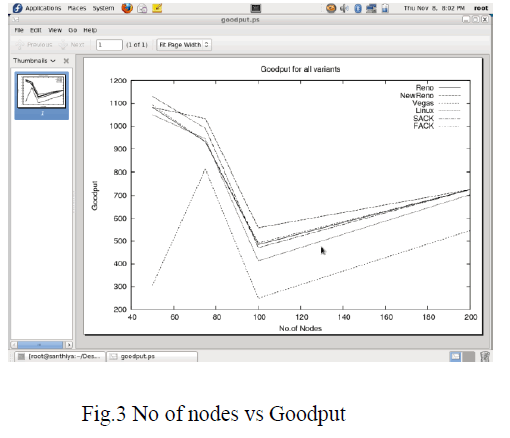 |
| The simulation result of number of nodes vs throughput is shown in fig 6.6. It shows that an exclusive examination with the incorrect estimation of existing RTT, SRTT and RTO timers under different TCP variants such as Reno, New Reno, Vegas, Linux, SACK, FACK for vehicular network.In VANET, the throughput is linearly increases with number of nodes increases. The analysis was done with Bonn Motion mobility model (ManhattanGrid) that is built over NS-2 simulator. This can decrease TCP performance due to incorrect estimation of RTT times, resulting in unnecessary retransmission which produce excess of congestion in the network. |
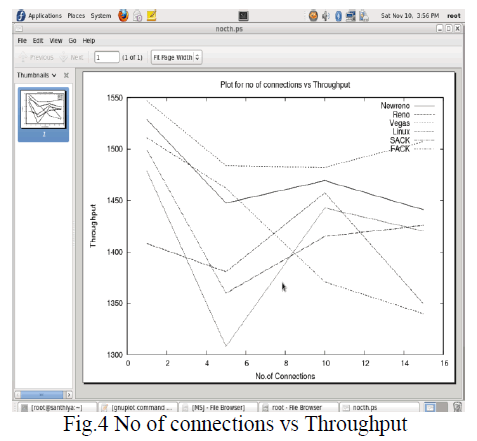 |
| The simulation result of number of nodes vs goodput is shown in fig 6.7. It shows that an exclusive examination with the incorrect estimation of existing RTT, SRTT and RTO timers under different TCP variants such as Reno, New Reno, Vegas, Linux, SACK, FACK for vehicular network. In VANET, the goodput is linearly increases with number of connections increases. The analysis was done with Bonn Motion mobility model (ManhattanGrid) that is built over NS- 2 simulator. This can decrease TCP performance due to incorrect estimation of RTT times, resulting in unnecessary retransmission which produce excess of congestion in the network |
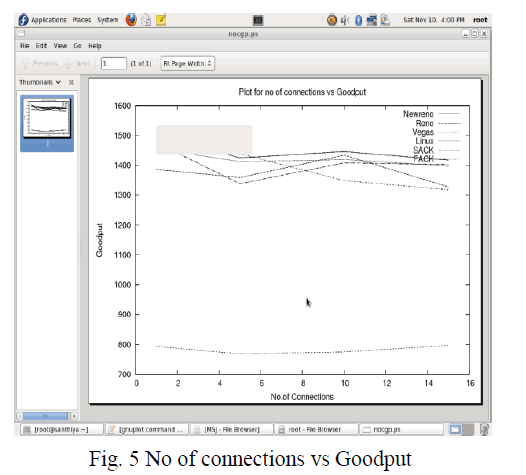 |
VII. CONCLUSION
|
| As a result, simulation from NS-2 shows that the performance of various existing TCP variants such as Reno, New Reno, Vegas, Linux, SACK, FACK in highly mobile environment (VANET) without the estimation of optimum value of RTT, SRTT and RTO timers. The existing TCP variants cannot yield good performance in highly mobile environment due to the fact that TCP is not able to differentiate packet drop occur from link failure with that of congestion in network. In the proposal, to overcome the problem of frequent retransmission, a significant RTT timer modification to be made at the TCP sender side for high mobility environment (VANET) in order to improve its performance. |
References
|
- Md. Abu Naser Bikas, “Experimental Analysis of AODV & DSR over TCP & CBR Connections with Varying Speed and Node Density inVANET”, International Journal of Computer Applications (0975 – 8887) Volume,(2011),
- Gongjun Yan, and Stephan Olariu, “Enhancing VANET Performance by Joint Adaptation of Transmission Power and Contention WindowSize” IEEE Transactions on parallel and distributed systems, Vol. 22, No. 9,SEPTEMBER 2011, pp. 1528-1535.
- Andrew Chen1, BehroozKhorashadi, Dipak Ghosal, Chen-Nee Chuah, “Impact of Transmission Power on TCP Performance in Vehicular AdHoc Networks”.
- Lars Wischhof and Hermann Rohling “Congestion Control in Vehicular Ad Hoc Networks” .
- ForouzanPirmohammadi , Mahmood Fathy , Hossein Ghaffarian ,(2012) “TCP AND UDP FAIRNESS IN VEHICULAR AD HOCNETWORKS”, International Journal of Emerging Technology and Advanced Engineering, ISSN 2250-2459, Volume 2.
- Miguel Sepulcre, Javier Gozalvez, Jerome Harri, and HannesHartentein, “IEEE 802.11p Performance Evaluation and Protocol Enhancement“, IEEE International Conference on Vehicular Electronics and Safety Columbus, September 22-24, 2008.
|